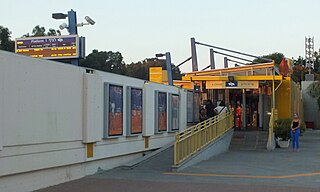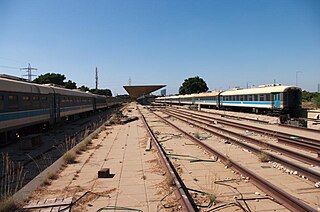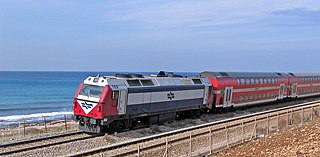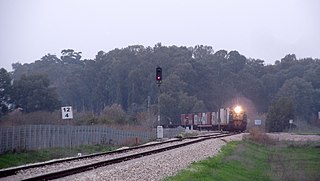
Tel Aviv-Yafo, usually referred to as just Tel Aviv, is the most populous city in the Gush Dan metropolitan area of Israel. Located on the Israeli Mediterranean coastline and with a population of 467,875, it is the economic and technological center of the country. If East Jerusalem is considered part of Israel, Tel Aviv is the country's second-most-populous city, after Jerusalem; if not, Tel Aviv is the most populous city, ahead of West Jerusalem.
Note: This compilation includes only those attacks that resulted in casualties. Attacks which did not kill or wound are not included.

Tel Aviv central bus station, also known as the new central bus station, is the main bus station of Tel Aviv, Israel. Located in the south of the city, it was opened on August 17, 1993. It is the second largest bus station in the world. The station in Tel Aviv covers 230,000 m2 and a total area of 44,000 m2.

Kiryat Haim railway station is an Israel Railways passenger station serving Haifa's borough of Kiryat Haim and its immediate surrounding region.

Haifa Center HaShmona railway station is an Israel Railways passenger station situated on the coastal railway main line and serves the City of Haifa.

Haifa Bat Galim railway station is an Israel Railways passenger station situated on the coastal railway line and serves the city of Haifa. The station takes its name from the neighborhood of Bat Galim, where it is located. The station was Haifa's main train station from its construction in 1975 until the early 2000s.

Binyamina railway station is an Israel Railways passenger station located in the region of Binyamina-Giv'at Ada and serves these towns, as well as Zikhron Ya'akov, Or Akiva and other small communities in the area.

The Tel Aviv Savidor Central railway station is a major railway station on the Ayalon Railway in central Tel Aviv, Israel, serving most lines of Israel Railways.

Hadera Ma'arav (West) railway station is an Israel Railways passenger station and freight terminal located in the city of Hadera. It serves the city, including its large industrial zones, as well as other small communities in the area.
The Hadera bus station suicide bombing was a 1994 Hamas suicide attack on a passenger bus departing from the central bus station in Hadera for Tel Aviv, Israel. As a result, five civilians were killed and 30 injured. The attack came exactly one week after another Hamas attack, the Afula Bus suicide bombing. Both attacks were motivated officially by Hamas as retribution for the Cave of the Patriarchs massacre conducted against Muslim worshippers in February by Baruch Goldstein. The attack took place on the Israeli Fallen Soldiers and Victims of Terrorism Remembrance Day.

The Dizengoff Street bus bombing was a Hamas suicide attack on a passenger bus driving down Dizengoff Street, Tel Aviv in 1994. At that time, it was the deadliest suicide bombing in Israeli history, and the first successful attack in Tel Aviv. 22 civilians were killed and 50 were injured. The attack was planned by Hamas chief Yahya Ayyash, on the eve of the signing of the Israel-Jordan Treaty of Peace.

Tel Aviv HaShalom railway station is a major railway station on the Ayalon Railway in central Tel Aviv, Israel, serving most lines of Israel Railways. It is located in the median of the Ayalon Highway at the HaShalom interchange, near the city's main commercial area and HaKirya IDF base. In 2019, over 15 million passengers used the station, making it the busiest in the country.
Prostitution in Israel was legal until December 2018, but organised prostitution in the form of brothels and pimping were prohibited. Legislation passed in the Knesset on 31 December 2018 that criminalises the "clients" of prostitutes came into force in May 2020, and was regulated since July 2020 under the Israeli Abolition of Prostitution Consumption Law, where fines will be cast for consumption of prostitution services from an adult. This legislation makes Israel the tenth country to adopt the "Nordic model". The Ministry of Social Affairs and Social Services estimates there to be 14,000 prostitutes in the country.

Tel Aviv South railway station was the name of two former railway stations in Tel Aviv, Israel, which were situated in two different locations. The original station opened in 1920, then in 1970 it was relocated 2.5 km south-east, and it finally closed to passengers in 1993.

The Coastal railway line is a mainline railway in Israel, which begins just south of the Lebanon-Israel border on the Mediterranean coast, near the town of Nahariya in Northern Israel and stretches almost the entire Mediterranean coast of the country, to just north of the border with the Gaza Strip in the south.
Events in the year 2002 in Israel.
On 22 December 2013, at approximately 2:30 pm, a pressure cooker bomb exploded on a public bus in Bat Yam, Israel. All casualties were averted because a few minutes earlier, a passenger on the bus had examined the contents of an unattended bag, and saw what looked like a bomb inside, which led all passengers and the driver to exit the vehicle. The bombing shattered or blew out all windows on the bus, and significantly damaged the interior.
The following is a timeline of the history of the city of Tel Aviv, Israel.

The Yarkon Railway is a double-track railroad following the course of the Yarkon River in the central area of Israel. It is about 15 km long, stretching from the Coastal Railway to the Eastern Railway.
On May 18, 1948, the Egyptian Air Force bombed the Old Tel Aviv central bus station four days after Israel declared independence, killing 42 people.













